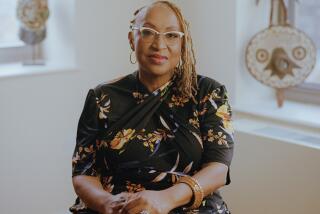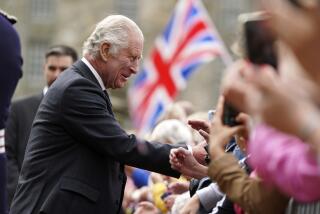A new image, a new image, their kingdom for a new image for King Richard III
- Share via
Today is an anniversary of deep importance to 2,000 Americans and several more thousands in Britain who believe that Richard III was a gentle man and a good king, and not the villain depicted in Shakespeare’s play and other 16th-Century works.
Specifically, these good people do not believe that Richard murdered the two little princes in the Tower, or ordered them murdered.
On Aug. 22, 1485--500 years ago today--Richard died in battle on the field at Bosworth, where, as we all know, he was last heard shouting, “A horse, a horse, my kingdom for a horse.”
That is all that most of us know of Richard, except that, to remove them as heirs to the crown, he locked up the Prince of Wales (Edward V), 12, and the Duke of York, 9, and had them smothered in their beds.
As moviegoers we are also familiar with Richard from “The Goodbye Girl,” for which Richard Dreyfuss won an Oscar. In one hilarious scene, Dreyfuss, as an Off-Broadway actor, portrayed the king as a hunchback and a rampant homosexual.
I am reminded of today’s significance by Jan Martin of Los Alamitos, who recalls that we discussed the murder of the princes when we met a few years ago.
“You thought Richard was the murderer,” she says. “Well, balderdash!”
Martin is one of about 50 Southern California members of the Richard III Society, which is dedicated to the king’s exoneration in the murders and the rehabilitation of his name. “The Richard III Society in Southern California is flourishing,” she says, “and this may be your last chance to join the proper side. So Jack, get with the program! Loyaulte me lie.”
(That was Richard’s motto--”Loyalty binds me!”--and it has been adopted by the society.)
Nine local members will be in England today, she says, for a re-enactment of the battle on Bosworth Field. She encloses a handout noting that Richard was “probably the most maligned monarch ever to sit on England’s throne, thanks to William Shakespeare’s dramatic powers. It is Shakespeare’s evil Richard that sticks in people’s minds. But more than ever before, the king has his champions. . . .”
Shakespeare’s evil Richard does indeed stick in the mind. We hear him employ the greedy Tyrrel to kill the boys:
K. Rich. Dar’st thou resolve to kill a friend of mine?
Tyr. Please you; but I had rather kill two enemies.
K. Rich. Why, then thou hast it; two deep enemies. . . . I mean those bastards in the Tower. . . .
Tyrrel undertakes the task and hires two assassins, Dighton and Forrest, to do it. These two, callous though they are, “wept like to children” when they told the story of “the gentle babes . . . girdling one another within their alabaster innocent arms.”
Richard is pleased, but wants to be sure.
K. Rich. But didst thou see them dead?
Tyr. I did my lord.
K. Rich. And buried, gentle Tyrrel?
In 1674 some workmen found the bones of two children under a stairway in the White Tower. In 1933, a scientific study showed that they were the bones of two boys, one about three years younger than the other. It was assumed in 1674 that they were the princes, and this seemed to bear it out.
Oddly, the most effective defense of Richard was “The Daughter of Time,” a novel written by Josephine Tey, an excellent British detective story writer. Her title comes from the old proverb, “Truth is the daughter of time.”
In this clever book, copyrighted in 1951, Tey’s popular hero, Scotland Yard inspector Alan Grant, is in hospital, as the British say, with a broken leg. He sees a picture of Richard, and, going on his detective instincts, believes a man with that face could not have murdered the princes.
With legwork supplied by his actress friend, a fellow inspector, and a young American researcher, he begins to investigate Richard’s alleged crimes. He concludes that Shakespeare’s account was based on Sir Thomas More’s account, and that More was in the service of Richard’s successors, the Tudors, and merely did a hatchet job on him.
Grant finds no contemporary accounts of Richard’s murders, and blames many others on the Earl of Richmond (Henry VII), who killed Richard at Bosworth and succeeded to the crown.
To me the most distasteful image of Richard in Shakespeare is not that of the cold and ambitious murderer of Henry VI, Clarence, Hastings, Buckingham and the princes, but of the unctuous suitor of the princes’ older sister, Elizabeth. He asks Elizabeth’s mother, who calls him “that bottled spider, that foul hunchbacked toad,” to speak to Elizabeth for him. She is naturally appalled.
Richard tells her, “Look, what is done can not be now amended. . . . If I did take the kingdom from your sons, to make amends I’ll give it to your daughter. If I have killed the issue of your womb, to quicken your increase, I will beget mine issue of your blood upon your daughter. . . .” (Is there a more monstrous effrontery in all literature?)
Much as I hate injustice, I am too much in the grip of Shakespeare’s power to be seduced by the felicities of Josephine Tey’s ingenious novel.
As Winston Churchill said: “No fact stands forth more unchallengeable than that the overwhelming majority of the nation was convinced that Richard had used his power as Protector to usurp the crown and that the princes had disappeared in the Tower. It will take many ingenious books to raise this issue to the dignity of a historical controversy.”
I say he done it.
More to Read
The biggest entertainment stories
Get our big stories about Hollywood, film, television, music, arts, culture and more right in your inbox as soon as they publish.
You may occasionally receive promotional content from the Los Angeles Times.










